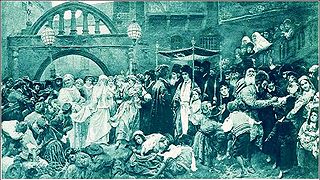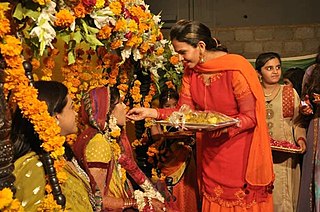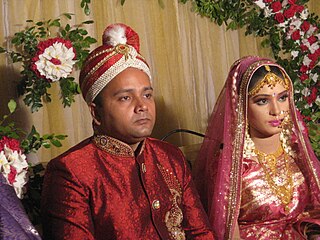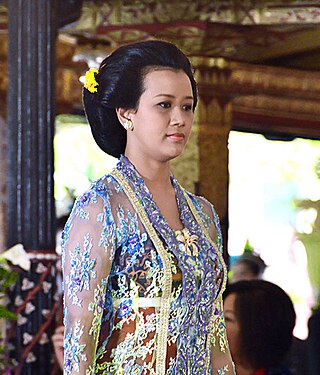Traditional wedding ceremony in Indonesia
Java (Surakarta) wedding ceremony

Nontoni
Nontoni is a ceremony to see the potential partner to be married. In the past, people who are getting married do not necessarily know the person they are going to marry or have never even seen it, although it is also possible that they already know or have seen each other. [11]
In order to have an idea of who the match will be, the Nontoni procedure is held. Usually this procedure is initiated by the men. After the parents of the man who will be arranged marriages have sent their investigation about the condition of the girl who will be made daughter-in-law. This investigation is called dom sumuruping banyu or secret investigation. [12]
After the results of this nontoni are satisfactory, and the male is able to accept the choice of his parents, then a discussion is held among the parents to determine the procedure for proposal. [12]
Marriage proposal ceremony
On the day of the marriage proposal that has been set, the parents of the groom-to-be come with gifts. In ancient times, what was commonly called Jodang (a place for food and so on) was carried by four men.
The food that is brought is glutinous-based food which has a meaning as the nature of the glutinous raw material which has a lot of gluten so that it is sticky and it is hoped that in the future the two brides and inter-besan will stay together.
After the wedding proposal is received, then both parties negotiate a good day to carry out the peningsetan ceremony.
Tarub ceremony
Tarub is a decoration of yellow janur (young coconut leaves) attached to the edge of a tratag made of bleketepe (woven green coconut leaves). [13]
The installation of the tarub is usually installed at the same time as bathing the bride and groom (siraman, Javanese), which is one day before the wedding is held.
Nyantri
The nyantri ceremony is to entrust the groom to the bride's family 1 to 2 days before the wedding. The groom will be placed at the house of relatives or close neighbors. [14]
This nyantri ceremony is intended to make the wedding ceremony run smoothly, so that when the wedding ceremony is held, the groom is ready to be in place so that it does not bother the bride's family.
Siraman
Siraman ceremony from the word siram (Javanese) which means bathing. What is meant by siraman is to bathe the bride and groom which means to clean oneself to be holy and pure. [15]
Midodareni
Midodareni comes from the word widodari (Javanese) which means daughter from heaven who is very beautiful and very fragrant. [16]
Midodareni is usually held between 18.00 and 24.00. Also known as Midodareni Night, the bride and groom are not allowed to sleep. [16]
Langkahan
Langkahan comes from the word langkah (Javanese) which means jump, the langkahan ceremony here is intended if the bride married before her unmarried sister or brother, then before the marriage contract begins, the bride and groom are required to ask permission from the older sister or older brother who was stepped over. [17]

Ijab
Ijab or Ijab Kabul is the ratification of a marriage according to the religion of the bride and groom. Traditionally, in this ceremony, the bride's family gives / marries their child to the groom, and the groom's family receives the bride and is accompanied by the delivery of wedding gold for the bride. The ijab qobul ceremony is usually led by an officer from the office of religious affairs so that the terms and conditions of the ijab qobul will be valid according to religious law and witnessed by government officials or civil registration officers who will record their marriage in the government records [18]

Panggih
Panggih (Javanese) means to meet, after the marriage ceremony is complete, the Panggih ceremony can be carried out. The groom returns to his waiting place, while the bride returns to the bridal chamber. After everything is ready, the Panggih ceremony can begin immediately. [19]

Sunda wedding ceremony
Sundanese traditional weddings are currently more simplified, as a result of mixing with the provisions of Islamic law and "practical" values where "the bride" wants to be more simple.
The customs that are usually carried out include: worship (pengajian), siraman, "seren sumeren" for the bride and groom. Then sungkeman, "nincak endog” (stepping on eggs), "meuleum harupat" (burning seven sticks), "meupeuskeun kendi" (breaking a jug), sawer (given coins, yellow rice) and "ngaleupaskeun kanjut kunang" (releasing the coffers containing coins). [20]
After the traditional ceremony ends, the bride and groom and their families rest to wait for the wedding reception or known as walimahan.
Betawi wedding ceremony
Betawi traditional weddings are marked by a series of processions. It was preceded by a period of introduction through Mak Comblang (Matchmaker). Continued with wedding proposal,siraman, the procession of cutting a cantung or scraping bat feathers with a coin that is flanked and then cut out. Henna night, the bride reddened her toenails and fingernails with Henna. [21]
The highlight of the Betawi wedding ceremony is the Akad Nikah.
Batak wedding ceremony
Basically, the Batak Marriage Custom contains sacred values. It is said to be sacred because in the understanding of Batak traditional marriage, it means sacrifice for the parboru (bride's family) because they "sacrifice" giving a living human life which is their daughter to the paranak (the groom's family), so the groom family must also respecting the bride by sacrificing/dedicating one's life as well, which is slaughtering an animal (cow or buffalo), which then becomes a meal (traditional food) in the ceremony. [22]












